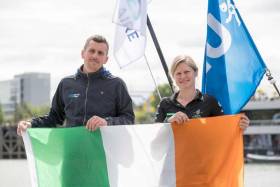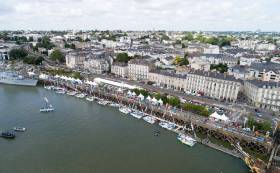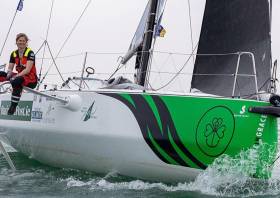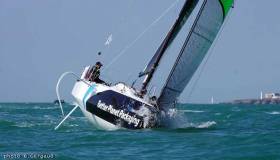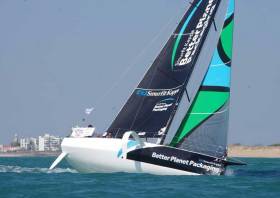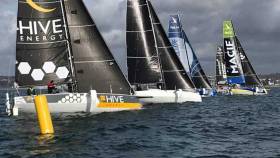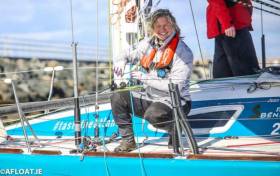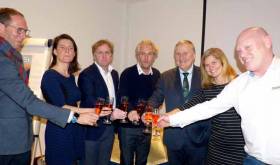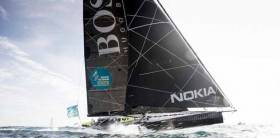Displaying items by tag: Figaro
Rather than any accumulated local knowledge it will be the strong, primal lure of returning to the homeland, Ireland, which might yield any additional speed advantage to Joan Mulloy and Tom Dolan when the two Irish solo racers compete on the 550 nautical miles La Solitaire URGO Le Figaro opening leg from Nantes in France to Kinsale starting Sunday.
Both of the Irish sailors have done most of their solo racing and training in France during their sailing careers and actually probably concede any extra knowledge of the Celtic Sea to some of their French counterparts, some of whom will have raced into Kinsale as much as a dozen times before.
This year’s 50th-anniversary edition of the annual multi-stage French offshore classic solo race has attracted an unprecedented entry of 47 skippers including double Vendée Globe winner Michel Desjoyeaux, three times La Solitaire winners Yann Eliès and Jérémie Beyou, French ocean racing legend Loick Peyron as well as several past overall winners. All have returned to La Solitaire because of the transition to the new lighter, faster, foil assisted Beneteau Figaro 3 one-design boat.
Tom Dolan, Skipper of Smurfit Kappa
This will be the second year of participation in La Solitaire for both Dolan, 32, the skipper of Smurfit Kappa who was brought up in a farm in Kells, County Meath and Mulloy, 33, skipper of Believe in Grace/Businesspost.ie from Westport, County Mayo in the west of Ireland.
And, after the stress and pressure of competing for the ‘bizuth’ or top rookie prize, both are pleased to be unshackled from the high expectations and ready to take on the four stage race with an open mind, keen to learn as much as possible over the coming month of racing, before the final stage finishes in Dieppe at the end of the month.
“I am surprisingly calm considering the start is Sunday but the boat is in good shape and everything is in place. As for me I have not had the training and preparation I had planned but I knew that would be the case a few months ago and so I take it as it is and just know that I will compete with every last fibre of my being to do as well as I can. I have such a great story with my sponsors Grace O’Malley and as soon as I knew I could do the race with them. I am so lucky to be here.” Mulloy smiles on the dock in Nantes on the Loire river at three days before the start.
“The fleet is wide open with this new boat. I have just done the one race solo and only a couple of weeks of solo training so it is important I approach this with the right mental approach and make progress. I won’t accept anything less from myself than trying to compete in the fleet.”
Mulloy raced one of the preliminary two-handed races, the Sardinha Cup, with four times Vendée Globe round the world racer Mike Golding.
“Mike was great. I learned so much from his unflappable approach, some of that comes with experience but also from the logical way he approached some of the manoeuvres and processes, he made it sound simple and when we came to do things that worked, but also he sat back and allowed be to back myself and my decisions and that gave me much more confidence in myself.
Dolan finished third rookie in the French Solo offshore championship last year and has had a solid preparation and build up, sailing the two handed warm up races with top Irish round the world racer Damian Foxall. He and Foxall finished 14th in the Sardinha Cup, fifth on the last leg, then 24th in the Solo Maitre Coq including a sixth on a short solo inshore. In both races he underlined that his nickname L’Irlandais Volant, the Flying Irishman, is as appropriate in the Figaro Beneteau 3 as it was in the Mini 650.
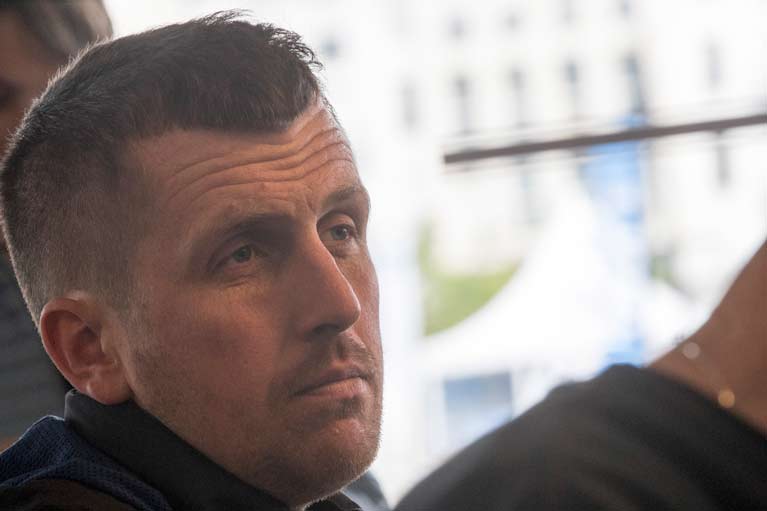 Tom Dolan at the Figaro briefing Photo: Alex Courcoux
Tom Dolan at the Figaro briefing Photo: Alex Courcoux
“I still have the speed and I am happy about that. The new boat has much more of the feel of the mini in the way you sail it and the feel and in the manoeuvres. I think I have had a good feel for speed since sailing Hobie cats and that has just carried on. There are one or two secrets I can’t tell you about!” Dolan quips. “In truth I am tired before the start but I think everyone is. I have to make that a positive and use that to really find the rhythm early on. It has been a long process prepping the boats and training and racing and then coming into the race. But I am very lucky. There is none of the pressure of the rookie thing last year, I know I am very lucky having Smurfit Kappa for three years and so there is no additional pressure other than my natural competitiveness.” Dolan adds, “But this is a long race. Four long legs. The first one is the home stop and I will be right up for doing the best I can. But I don’t have any special knowledge of the area. The crazy thing is I can remember only ten years ago being out at the Fastnet when I worked at the sailing school in Baltimore and seeing the Figaro racers out there then. Some of these guys are still racing or are back this time. I guess maybe that is where the dream started. But back then I never thought I would be here ten years on racing into Kinsale on La Solitaire. That is crazy, isn’t it?”
Preparations continue in Kinsale, County Cork to welcome the 50th Figaro Race race when the solo race returns to Ireland on June 6th.
As added interest for Irish race followers, the huge entry for this 50th-anniversary edition of La Solitaire URGO Le Figaro will have Irish participation too. Joan Mulloy and Tom Dolan will compete in the event that for the first time features a new foiler one-design boat. Full details were announced on Afloat in February by Jack Roy, President of Irish Sailing.
The transition to the new foil assisted VPLP designed Figaro Beneteau 3 has seen the return to the race of Beyou, Yann Eliès, Michel Desjoyeaux, Yoann Richomme, Loick Peyron, Alain Gautier and Armel Le Cleac'h, creating a sporting level which is unprecedented.
The upcoming four-stage race which starts on Sunday in Nantes and finishes at the end of the month in Dieppe after stages to Kinsale, Ireland, to Roscoff, a loop off Roscoff and a final leg to the finish.
The Figaro has been described as the “ Tour de France” on the ocean. In Kinsale, it is organised by a locally based voluntary committee, chaired by Tony Small assisted by EnCircle Na Farraige, an event management company.
Joan Mulloy is set to compete under the black sails of the Irish pirate queen — and fellow Mayo mariner — Grace O’Malley, the Figaro contender has announced.
Following a months-long drive to secure sponsorship for her sophomore Solitaire bid, Mulloy has now inked a deal to ‘Believe in Grace’ and showcase the Grace O’Malley whiskey brand in this year’s race as well as as in further offshore adventures as a solo sailor.
“Celebrating female leadership through rebellious spirit, this brand honours the legend of Grace O’Malley, regarded as one of Ireland’s but the world’s most inspirational and extraordinary female trailblazers,” Mulloy posted on social media today, Monday 20 May.
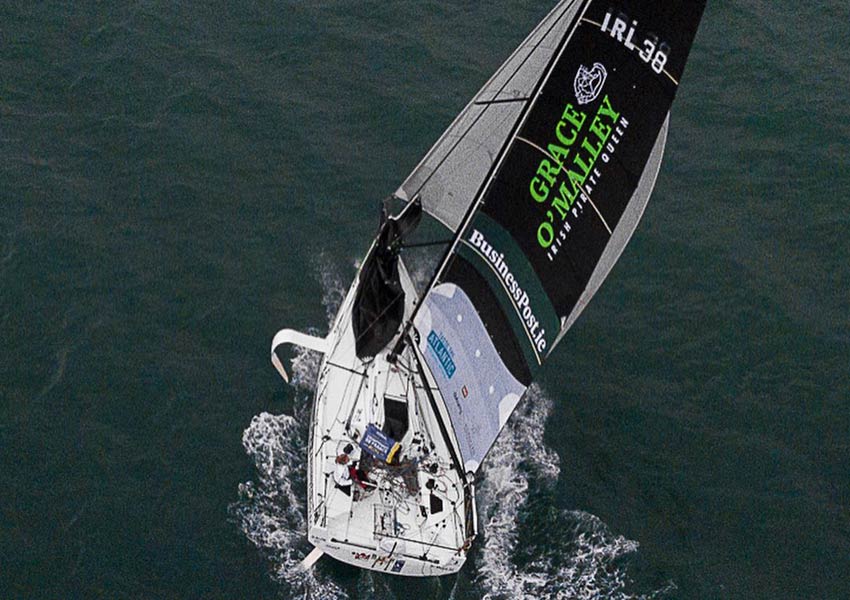
“Like their namesake, who earned her maintenance by land and sea, Grace O’Malley plunders fine spirits from the best of Ireland and worldwide adventures to create something truly special in and from the heart of Co Mayo.”
Mulloy’s most recent race was the Solo Maître Coq, where she placed 45th but not far behind the pack that included another Irish Figaro hopeful, Tom Dolan, in 28th.
Both will be racing in more local waters later this summer when the Solitaire URGO Le Figaro returns to Kinsale for the first time since 2009, as previously reported on Afloat.ie.
Dolan & Foxall's Excellent Final Leg Fifth Place in Sardinha Cup
After minor frustrations marred the first two legs of the Sardinha Cup, Ireland's Tom Dolan and Damian Foxall on Smurfit Kappa finished the first offshore series for the new Figaro Beneteau 3 class on a high note, securing an excellent fifth place on the 280 nautical miles third and final stage.
"That is more like the result we felt we were capable of. On the first two legs, we were sailing fast and generally going in the right direction. But this was a leg when most things went right." smiled Foxall on the dock this morning in Saint-Gilles Croix-De-Vie on the French Vendée coast, the host port of the event and 'home' to boatbuilders Beneteau.
After their 13th place in the shorter, opening Vendée Warm Up leg, then 20th on the first long offshore stage and their fifth on this leg - which was shortened this morning from the scheduled 320 miles to 280 miles - the Smurfit Kappa pair finish 13th overall
From a 'mediocre' start from Saint-Gilles-Crox-De-Vie on Thursday afternoon, the flying Irish duo hit their stride in breezes to 20 knots and proved fast on the 130 nautical miles downwind to a turning mark off Arcachon, south of Bordeaux. They were well inside the top ten of the 32 boat fleet at the southernmost turn.
Yesterday, Friday, Dolan and Foxall gained places on the ensuing upwind stage when there was little wind and the key was working the wind shift created as the sea breeze came in close to the land.
At one point they were up to fourth but a slight hiccup -dropping the spinnaker into the foil - cost them momentarily in the very close racing. Then the sensible choice was to consolidate and cover the fleet to secure the top 5.
"I'm happy with that." Dolan grinned, "It was disappointing not to hold on to good early positions on the first two stages, but this is more of a correct result in terms of how we have been sailing."
"We definitely had good speed again on the run and made our gybes at the right time. I have good sails from Technique Voiles, a smaller French loft, and with the big spinnaker, in particular, we seemed to be able to sail a little lower and stay fast." Dolan added.
Foxall, a veteran of ten round the world races whose first experience back with the Figaro class this was after a 20 years hiatus, added:
"Tom has been putting in the time and has good potential going forwards from here. It is a new boat, the Figaro Beneteau 3, and it will be a lot harder to sail solo, but this a great way to start the season for him."
"I really came in with no expectations at all." the round the world sailor from County Kerry admitted, "But in many ways, it is like riding a bike, the reflexes come back automatically and you get the boat going fast. Once we found the buttons to do that we seemed to be able to do that. He has good sails and has put in a lot of work with the Lorient training group."
Foxall moves on to his next major project now. Asked if his experience with the new Figaro and his ebullient compatriot Dolan might tempt him to return to the Figaro in which he cut his solo and short-handed teeth some 20 years ago, Foxall said: "I suppose it is 'never say never', but for sure it is great, great racing. It felt very familiar and it was nice to be in that comfort zone."
Won overall by three times La Solitaire champion Yann Eliès sailing with French-based British co-skipper Samantha Davies, the Sardinha Cup has been a useful first event for the fleet and for Dolan who now starts his solo training looking towards the season's pinnacle, June's La Solitaire URGO Le Figaro.
Smurfit Kappa, the new Figaro 3 being raced in the current Sardinha Cup series in France by Tom Dolan and Damian Foxall, has been comfortably in the top ten since the start of the 320-mile Leg 3 off St Gillles yesterday at 1330hrs. The course is south to a turning mark off Arcachon, then north leaving Ile d’Yeu to port before heading northwest to another turn before the final leg southeast to St Gilles, where the finish is expected tomorrow (Saturday).
"Smurfit Kappa has shown some impressive bursts of speed"
Smurfit Kappa has shown some impressive bursts of speed, but despite slower going since making the turn off Arcachon during the night, the Irish duo have been steppd up the challenge, and this morning are shown as a close third in line honours, just 1.1 miles astern of leaders Samantha Davies and Elies Yann in St Michel. The race has been slightly slower for Joan Mulloy and Mile Golding in Atlantic Youth Trust - they are shown at 29th in line honours, five miles astern.
Race Tracker here
Figaro Sardinha Leg 3 Will Now Start Tomorrow
The start of the Sardinha Cup Stage 3 for the new Beneteau Figaro 3 fleet has now been reset for 1330hrs local time tomorrow, Thursday, April 11th off St Gilles Croix de Ville, following a massive effort by the shore support teams and specialist squads from the manufacturers to put right serious rigging problems in several entrants. Originally scheduled for Tuesday, April 9th, this long race had looked for a while to need postponement to the weekend, but a very impressive display of repair and replacement resources is seeing the situation being sorted ahead of expectations.
Ireland’s Tom Dolan and Damian Foxall are itching to get back out racing again, as their boat Smurfit Kappa has shown as a real contender, and when they became fouled in abandoned fishing gear in hard driving in the middle of Stage 2, they were actually within shouting distance of the lead on the water. As it is, after two stages raced they are currently lying 19th overall, but it seems unlikely they’ll be able to demonstrate their notable heavy weather skills, as the expected winds are currently not forecast to go above 15-16 knots.
Figaro Sardinha Cup Fleet Delayed in Port by Damage Repairs
After the heavy going experienced for much of the first two stages of the Sardinha Cup for the brand new Figaro 3 boats, a significant part of the fleet had sustained such serious rig problems that the long-distance Leg 3 has been postponed until the weekend in order to allow round-the-clock working in port at St Gilles Croix de Vie in order to get the boats ocean ready once more.
Ironically, the Bay of Biscay is now experiencing extremely light winds for the time of year, but the strong breezes may have returned when the fleet puts back to sea. Ireland’s Tom Dolan and Damian Foxall on Smurfit Kappa had their own problems when they became enmeshed in fishing gear while well placed during Leg 2, and currently are well down the line with a 13th and a 20th recorded in the two legs sailed, while Joan Mulloy and Mike Golding were early victims of the technical failures and had to put into the nearest port.
Joan Mulloy’s 2019 Figaro bid gets a step closer to reality as the first race of the season, the Sardinha Cup, comes in just a few days’ time.
Mulloy, who made her debut in the Figaro last year, has been juggling training with the sponsorship hunt for the last few months, and describes the prospect of her first race back as “a little intimidating”.
But from early next week her focus will be squarely on her Beneteau Figaro 3, which she will be racing with experienced co-skipper Mike Golding.
“Mike will bring a lot of experience to the team, with four Vendée Globes under his belt, but we will both be very much finding our feet for this race,” she says.
Mulloy and Golding will be part of a “pretty intense” lineup that includes more than a few offshore legends — and fellow Irish in the combination of last season’s third overall rookie Tom Dolan and Volvo Ocean Race veteran Damian Foxall.
“I’m very excited to be back on the circuit again this year, but it hasn’t been an easy winter in terms of finding sponsors,” Mulloy says, confirming that she will be starting this first race without a title sponsor.
She adds: “I have some good news in the pipeline, but not quite enough to see me to the end of the Solitaire.”
This year’s Solitaire URGO Le Figaro returns to Kinsale for the first time since 2009.
However, the Figaro is not Mulloy’s only campaign of his season, as she has also been conformed as co-skipper for Alexia Barrier in her IMOCA 60 4myplanet in this year’s Fastnet and Transat Jacques Vabre Races.
“These races give me crucial qualifying miles towards the Vendée Globe,” she says of her ultimate goal. “There are approximately 12 places left in the 2020 Vendée Globe, after those allocated for new boats or previous race competitors.
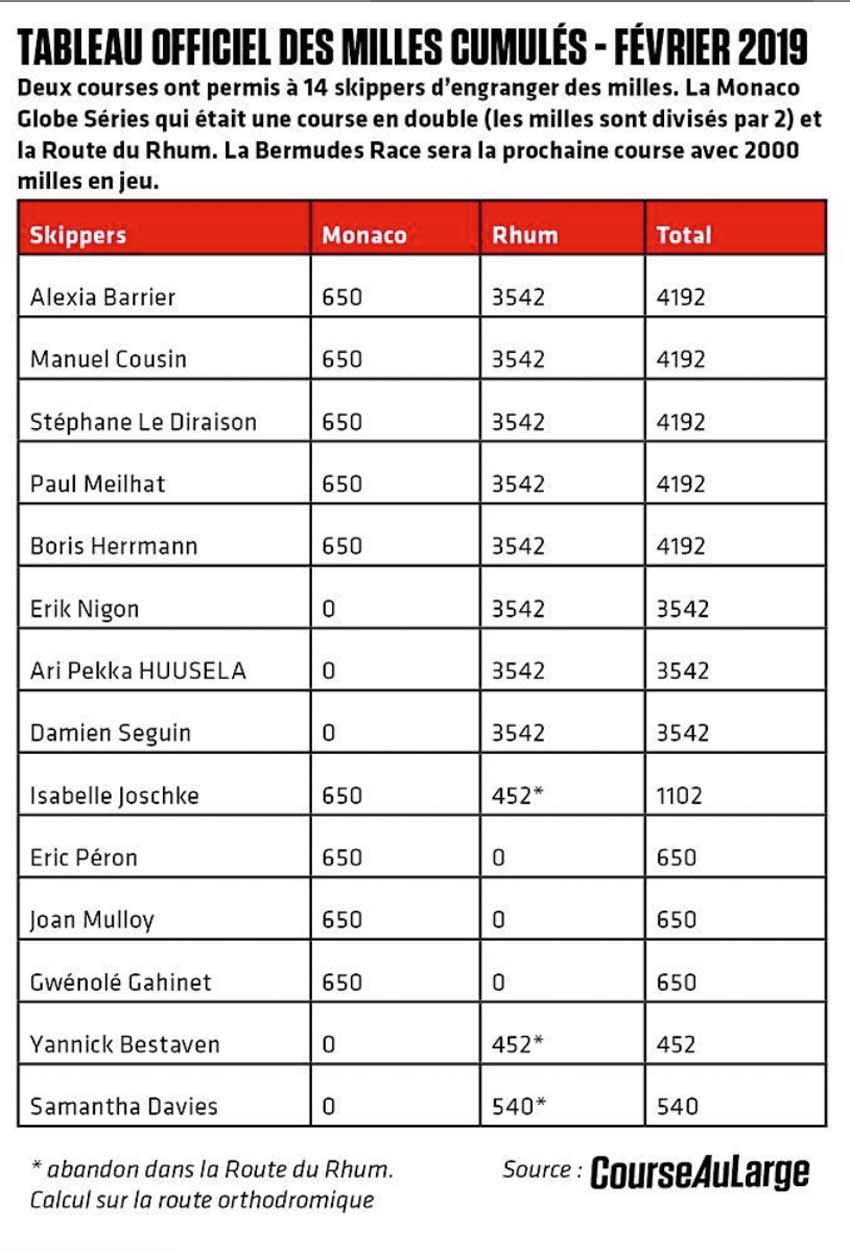
“These 12 places are allocated based on accumulated qualifying miles … I am currently 11th on this list and so working hard to stay here is very important.”
From next Wednesday follow Joan Mulloy’s progress (as well as Dolan and Foxall) on the Sardinha Cup race tracker HERE.
Kinsale to Host 50th La Solitaire Urgo Le Figaro Race
Ireland will host the 50th Figaro Race 6th/ 9th June next. Two Irish Skippers, Joan Mulloy and Tom Dolan will compete in the event that for the first time features a new foiler one-design boat. Full details were announced on Thursday in Cork by Jack Roy, President of Irish Sailing.
The Figaro has been described as the “ Tour de France” on the ocean. It will be organised by a locally based voluntary committee, chaired by Tony Small assisted by EnCircle Na Farraige, an event management company. It will also be supported by the Atlantic Youth Trust, whose mission is to connect youth with the ocean and adventure with a schools youth activation programme promoting the Figaro, Seafest and the maritime.
 Figaro competitor Joan Mulloy from County Mayo
Figaro competitor Joan Mulloy from County Mayo
“It's exciting and will be a major boost for Kinsale, Cork and Seafest. And now, that we have won the opportunity to host the event, it's critical now to win the support of all tourism, business and community interests in the area” Tony Small said. He added that facilities to be provided by Castlepark Marina and the positive attitude of the business community in Kinsale was great, but it now needs to be converted to action.
“Being the 50th running of the event I remember it as a child, sailing my Mirror when these amazing Figaro sailors arrived?” Ciaran Fitzgerald, Kinsale Chamber and of the Blue Haven said.
Spread over a month, The Figaro route is tough. The first leg is 550 miles from Nantes and around the Fastnet Rock to Kinsale. From here a short prologue to Cork Harbour and then its 615 miles around the Isle of man Roscoff. From here it’s a 450 mile Channel course around the Scilly Isles and Jersey back to Roscoff and then a final 450-mile leg to Dieppe for a Grand Finale.
 The 50th Figaro route
The 50th Figaro route
In the build-up to the event, it is hoped that Schools Programme around Cork and Munster will visit schools to promote the event, backed with a social media campaign, print and digital activation. This would be co-ordinated through the Atlantic Youth Trust Charity. Also, it is hoped to bring maritime interests together and the backing of the Department of Marine, the Cork City Council Seafest organizers and Irish sailing and adventure sport tourism interests.
The idea is that on Sunday 9th a June a major on-the-water spectacle in Cork Harbour and Kinsale will be created. The Figaro Fleet would depart Kinsale in the morning in a Prologue Race to Cork Harbour. Each professional Figaro Skipper would have a group of selected Youth from the Schools Programme for the opportunity of a lifetime. Then in Cork Harbour, the youth would be taken off by rib and the major race would start with a plan to mobilize on the water every boat and it is hoped one of the Irish TV channels will televise it live,
The solo offshore sailing world has three or four flagship events, such as the Vendée Globe the Route du Rhum and the Mini Transat, but without question, the senior race amongst them all is the Solitaire URGO Le Figaro. In 2019 the event will celebrate its 50th edition, and the race will be sailed in the brand new Figaro Beneteau 3 One Design Class
The annual event’s competition format is unusual in that it features four legs, each lasting three to four days, with a two to three-day stopover between each restart. The event is scored on cumulative elapsed time, that is to say, that the combined times for each competitor over the four legs will decide the final ranking.
Initially backed by the French national newspaper Le Figaro the goal at the time was to sell newspapers during the summer months with the amazing stories of the solo sailors. Fifty years later the event draws major coverage across all media. A professional sport and significant industry has grown up around this event over the past five decades, most French offshore sailing stars, now household names, have in turn gone on to win the other major solo offshore races from the experience and notoriety they gained competing in the ‘mother of all’ singlehanded offshore events.
Today the Solitaire URGO Le Figaro represents the pinnacle of the singlehanded offshore sailing sport, with teams training year round. The competition is sailed in identical 30 foot long One Design boats. The race is physically and mentally challenging with skippers needing to remain alert and on deck for the entire period, often getting little more than 2 to 3 hours sleep every 24 hours in little bursts of 10 minutes at a time.
The technologies used today are a far cry from even 20 years ago, with boats and sails built using advanced composites, skippers needing to be adept at getting the most from their powerful on board computers and software, used to optimise navigation and on board weather forecasting (no outside assistance is allowed), along with highly sophisticated autopilot systems. Significantly one of the spinoffs of the race over the years has been the development of safety equipment and seamanship techniques that are now widely adopted across all walks of the professional and leisure boating industry.
This year with the arrival of the new class of boat, the Figaro Beneteau 3, a foil-assisted lightweight high speed design, many of the past winners have decided to return to the class to line up against the newcomers and the class stalwarts.
The race has a strong affinity with Irish sailing too, not just because of visiting Irish waters but because six different Irish skippers have competed with distinction in the event over the past 30 years. This year two Irish skippers - Westport’s Joan Mulloy and Mullingar’s Tom Dolan - will both be competing for the second time. Other Irish skippers that have competed include Damian Foxall, Marcus Hutchinson, Paul O’Rian and David Kenefick.
Kinsale welcomes the event with open arms. The first boats to finish in Kinsale are expected sometime late on Wednesday 5th June. The skippers will relax and recover from the 600-mile leg from Nantes in France before making final arrangements for the start of Leg 2 from Kinsale to Roscoff in Northern France, which will take place on Sunday 9th June. Each skipper is supported by shore crew including technicians and press officers at each stopover, and when added to the race organisation staff the travelling caravan consists of more than 250 people. The pontoons where the fleet will be moored will be open to the public and the prizegiving ceremonies will take place at Market Square – likewise, on the Sunday Race start, a major spectacle in Cork Harbour will be created.
Further information Donal Small [email protected] and mobile: + 353831831057
Are Today’s Boats Getting in the Way of Sailing’s Popularity?
The sailing community’s notable diversity is dependent on how you’re trying to analyse it writes W M Nixon. For many, it’s the community aspect, the shared love of boats and sailing and interacting with sea or lake, which is the sport’s greatest appeal. But for others, the greatest attraction is because it’s a competitive vehicle sport.
In fact, it could be argued that a useful indicator of where you fit into the complex sailing world is your place along the boats-to-people continuum. At one extreme, there are those for whom the boat and her equipment is everything. And at the other end of this boats-to-people line, there are those for whom the successful interaction of the crew, the people management side, is paramount – organising the boat and dealing with her technical problems is something for specialized members of the team.
Not so long ago, while cruising the Hebrides, we met up with one of the purest boat nuts I’ve ever encountered, even if he did offset this tendency by using his superbly-maintained boat for very interesting projects.
We liked the look of his 34ft cutter, and as we were in a sublimely beautiful anchorage where no-one was in a hurry to move on in the morning, we inveigled an invitation aboard and were bowled over by the quality of everything on his boat, the maintenance, and the careful way it had been thought through to make his cruising as comfortable and practical as possible.
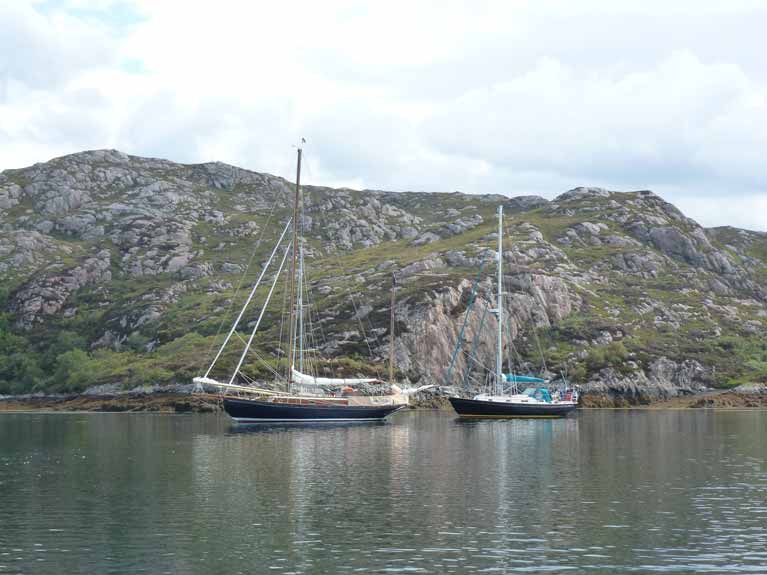 “ Sailing” as its cruising participants like it – an idyllic summer morning in the Hebrides for the veteran Ainmara (left) and the superbly organised Victoria 34 cutter Sula. Photo: W M Nixon
“ Sailing” as its cruising participants like it – an idyllic summer morning in the Hebrides for the veteran Ainmara (left) and the superbly organised Victoria 34 cutter Sula. Photo: W M Nixon
For instance, he’d re-wired the boat completely by himself, and had done it in such a way that although everything seemed invisible and skilfully done, the simple opening of accessible locker doors in key areas revealed all the parts that needed to be easily reached.
It was a pure case of single-minded perfection, so much so that we were thinking of ways to entice him to Ireland some time to give our own boats the same treatment. But in his case, “single-minded” was the essence of it all. He’d once sailed alone in a Wayfarer from Scotland across the North Sea to Norway, but few knew of it because he did it for his own satisfaction – publicity wasn’t of interest to him.
And now, after we’d had coffee together, he was off across to Skye to climb in the Cuillins. On his own, of course, and using that perfect solo-sailed boat as a handy base camp. This was indeed a man who marched to the beat of a different drum. For our part, we were nipping across to Plockton on Loch Carron, a notably convivial place, to continue a cruise of sociable celebrations.
As far as we were concerned, this was cruising as it should be, and cruising lends itself to accommodating every level of direct or indirect boat technical involvement. However, cruising is a world in itself. But in racing, the fact of sailing being a vehicle sport immediately puts a wall between it and most other sports, particularly those stadium sports of greatest public interest.
 Is this sailing’s Formula 1? The America’s Cup boats of 2013 were foiling multihulls
Is this sailing’s Formula 1? The America’s Cup boats of 2013 were foiling multihulls
 The America’s Cup rings the changes – and whatever they are, they’re always expensive. The next series in New Zealand will be raced in 75ft foiling mono-hulls
The America’s Cup rings the changes – and whatever they are, they’re always expensive. The next series in New Zealand will be raced in 75ft foiling mono-hulls
So in trying to increase sailing’s public awareness, we quickly find people referencing Formula 1 car racing, and claiming that sailing will only find universal appeal if its major events are staged in the most spectacular boats available.
Certainly, this has long been the way of the America’s Cup. But that’s quite obviously a sailing spectacular for people to stare at in wonderment, rather than expect any sense or possibility of personal involvement.
However, the Olympics are different. Olympic sailing is arguably the kind of sailing we can do at club level but carried to the ultimate extremes of personal high performance. But is that necessarily the way that sailing should go? In a tech-obsessed era - a state we’ve arguably lived in since man chipped his first flint axe-head – there are those who would argue that the boats used in the Olympics should be at the furthest edge of technological development.
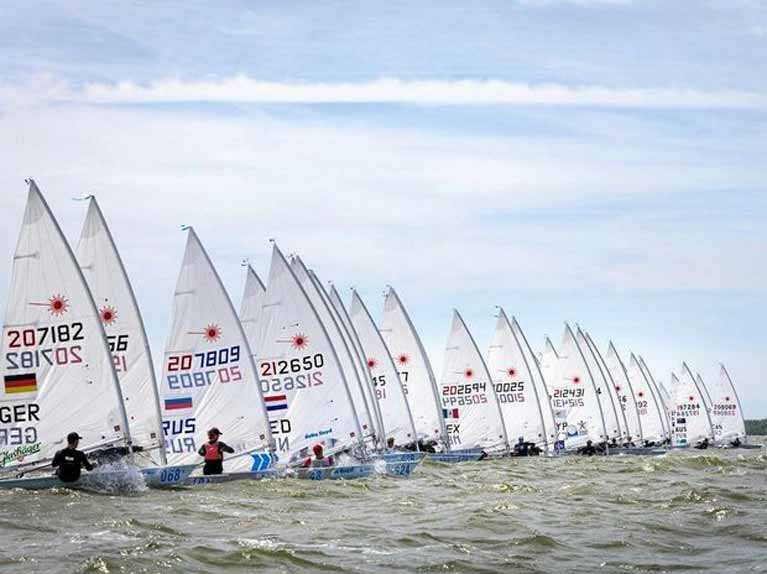 For club sailors, the fact that their popular Laser is an Olympic Class is seen as a bonus. But for the casual viewing public, could it possibly be that a large fleet of Lasers is not the most exciting or comprehensible sporting vista in the world?
For club sailors, the fact that their popular Laser is an Olympic Class is seen as a bonus. But for the casual viewing public, could it possibly be that a large fleet of Lasers is not the most exciting or comprehensible sporting vista in the world?
This is their point in arguing that today’s boats are getting in the way of developing sailing’s popularity. In a sense, they argue that by using popular everyday boats for a television spectacular like the Olympics, the powers-that-be are making the images decidedly humdrum for an audience steeped in technological wizardry.
It’s an approach which came to a head a month ago when, thanks to the remarkably high Irish representation in the committees of World Sailing – a priceless inheritance from the determinedly internationalist days of Dun Laoghaire’s Ken Ryan – we were among the first to be able to report the confirmation about the inclusion of an offshore racer (to be crewed by a woman and a man) in the lineup for the 2024 Olympics at Paris, when the sailing will be at Marseille.
The boat proposed will be between 6 and 10 metres overall, and non-foiling. With the course planned to have them at sea for three days and two nights, it will be the longest event in the Olympics, and all boats will be connected for sound and vision 24/7, so the human interest levels should be very high indeed.
 Tom Dolan with his Figaro 2 Smurfit-Kappa. This highly-regarded 2002 Marc Lombard design is now categorized by the builders as a “Heritage Boat”
Tom Dolan with his Figaro 2 Smurfit-Kappa. This highly-regarded 2002 Marc Lombard design is now categorized by the builders as a “Heritage Boat”
This confirmation (at last) marked such a change to the Olympic sailing format that it provoked a considerable immediate reaction. But working on the policy that second thoughts are often best and usually less harmful, we persuaded some of our more outspoken reactors to tone it down a little with the promise that we’d keep them anonymous for the time being, and would publish after a reasonable interval.
However, now we’re in the buildup to Christmas when true sailors rely on the thought of the Rolex Sydney-Hobart Race to preserve their sanity in the midst of smothering seasonal cheer. So here’s something else altogether - shot from both barrels - to provide something similar:
“I am no doubtless connected with the ‘higher governance level’ of our beloved sport than yourself or others, but the ‘design’ brief of the intended boat for Paris 2024 Offshore event (quote:“…..boat which will be used, the length overall will be between 6 metres and 10 metres, definitely non-foiling, and currently talked of as sloop rig with spinnaker…”) shows, yet again, how out of touch World Sailing is with its own sport!
The IMOCA 60 Class is progressively shifting to foil (see Route du Rhum 2018) and the Mini 6.50 class rules now allow foils, wingsails and even kites, while the new America’s Cup boat won’t even have a keel but 2 foils (etc etc…there are many other examples). Thus the notion that ‘what the public wants to see in the Olympics are non-foiling monohulls of 6 to 10m LOA’ baffles me!!!
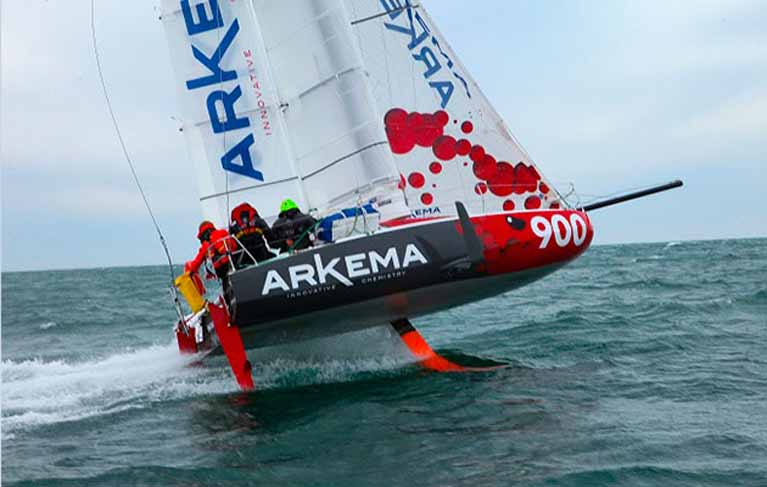 The Mini 6.50 class now permits foils, and even with three on board, the little boat lifts and flies
The Mini 6.50 class now permits foils, and even with three on board, the little boat lifts and flies
Paris won the 2024 Olympic Games. Sailing is one of the Olympic Sports. Olympic Sailing attracts very little spectators and/or much less TV audience than the ‘professionally organised circuits’ (Minis, Figaros, IMOCAs, big multihulls, Route du Rhum, Vendee Globe etc etc…).
The aim is to change this and for once, France as the organiser and for all sailing nations, may stand a chance to make some Olympic sailing look sexy! And as you mention, there already had been an attempt – scheduled for June 2018 – to preview a potential Olympic offshore race
Nicolas Hénard, President of the Federation Francaise de Voile, declared:
« …We are the nation of offshore sailing, we can’t afford to miss this (opportunity). This is why I am doing the forcing on this with the organisation of a showcase event in Marseilles in June (2018) in parallel with the finals of the Worlds Cup with five Figaro 3 on loan from Beneteau…”
Unfortunately, due to funding issues, this demo event was cancelled…but of course the demo support was the Figaro 3.
Staging a new Olympic discipline in 2024 on a boat that, though not yet selected, is already outdated in 2018 for the intended purpose is ludicrous.
This is even more so for the Figaro 2 as the article suggests, a boat launched in 2002 and classified on the Beneteau website itself under the heading ‘Heritage”
Also, my understanding is that, for an Olympic sailing event, boats have to be supplied (I guess new?!) by the organisers…hardly Figaro 2s then…
The reality is that:
• The Figaro Class and Circuit is the ‘only game in town’ worldwide for an ‘affordable’ (€210k ex. VAT including sails, electronics and safety equipment), one-design, short-handed, offshore racing class
• The Figaro Class is moving to foiling from 2019 onwards with the F3 because this is:
◦ What the competitors (read athletes for the Olympics) want!
◦ What the sport, as an offshore discipline, is at…right now, let alone in 2024
◦ What the viewing public demands
 It could be argued that the foiling Figaro 3 is no longer an extreme concept, and by 2024 it may even seem a little dated
It could be argued that the foiling Figaro 3 is no longer an extreme concept, and by 2024 it may even seem a little dated
The current ’design brief’ of the World Sailing Equipment Committee for the new proposed event in Marseilles 2024 can only be explained by either
- A complete misunderstanding of the sport (really?) or
- Anything BUT a Beneteau Figaro 3 attitude resulting from pressure/lobbying from other National Sailing Federations or other boat manufacturers who do not have an ‘affordable’ one-design offshore sailing boat in production or even in draft (J Composite?) in an attempt to ‘not give an unfair advantage to French Figaro sailors starting on this support from March 2019!
- If there are doubts that a new boat like the Figaro 3 will be available in sufficient number, FYI, Beneteau is rolling out one new Figaro 3 per week as we speak! That’s further good news, So the question for World Sailing is:
- Do we specify the boat that’s required and expected (FYI, I do not have any interest whatsoever in Beneteau ?)?
- Do we specify another one for political reasons and launch a new discipline in 2024 on an outdated support?
As for my ‘dream team’: Tom Dolan (French offshore circuit ‘veteran’, inc. Figaro circuit) and Annalise Murphy (3 Olympic campaigns by 2020, Moth sailor, Volvo Ocean Race veteran etc, would bring this event very much alive if they were racing a Figaro 3, or perhaps even its 2024 development.”
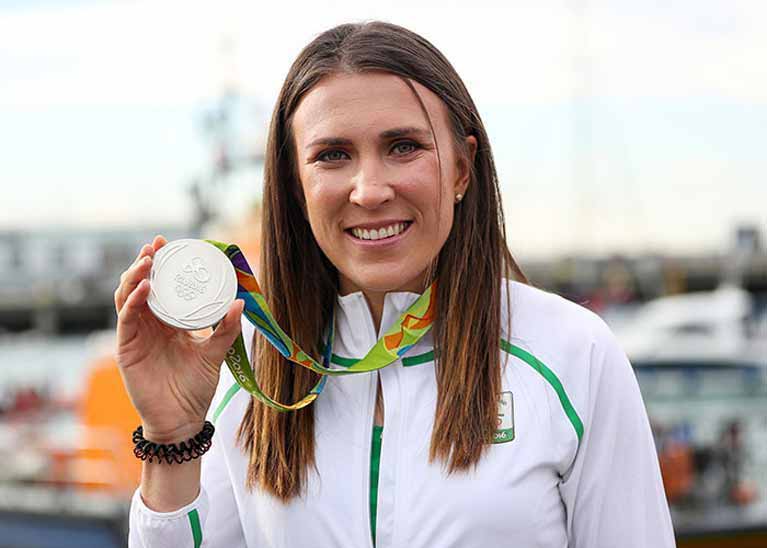
 Dream team – Olympic Medallist Annalise Murphy and Figaro veteran Tom Dolan
Dream team – Olympic Medallist Annalise Murphy and Figaro veteran Tom Dolan
Well, that’s telling it like it is – or might be. Instead of trying to minimise Olympic sailing’s vehicle sport aspect (which the 49er turns on its head anyway), World Sailing and the Paris/Marseille Olympics should go hell for leather for the most technologically-advanced yet economically-feasible boat possible.
It’s quite a challenge in itself. And if it seems a very long way from our agreeable meanderings about a perfect little cruising boat met with in the Hebrides, well, that’s the way it is – sailing is a very complex sport however you look at it.



























